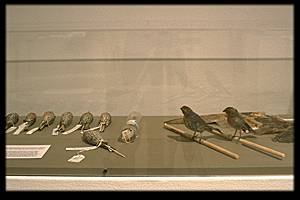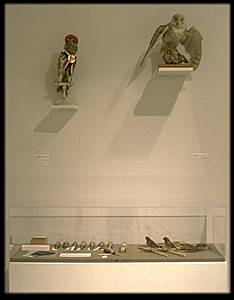The ubiquitous presence of birds in this space as well as that of the curiosity cabinet, illustrates the fluidity of modern boundaries and categories. Birds in various forms, and bird related items, are included in every department's collection. That birds are collected by so many departments shows how context and category define function and meaning, not vice versa.
Chicken skeleton
Paleontology collection, Geology
Dove skeleton
Anthropology
Barn Owl skeleton
Museum of Systematics and Ecology, Biological Sciences
Dove skeleton
Art Studio
Bird skeletons are used in several departments, for slightly different purposes. In Anthropology, the skeleton aids students in identifying animal bones in human garbage in order to study human diet. In Paleontology, the skeleton aids students in identifying and visualizing complete skeletons from fragmentary fossils; in Biology, it is a specimen, one of many ways of preserving a particular type of bird used in the study of ecology and other fields. In Art Studio, skeletons are used to study and learn to depict anatomical structure.
Sparrows
Museum of Systematics and Ecology, Biological Sciences
A dead animal is never simply an inert specimen. The "method" of investigating a specimen it changes what we learn from it. Nor is the information static. As research methods change, it is possible to go back to the original specimen and learn new things, especially about how species change over time. Most commonly birds are maintained in biology collections as skins lightly stuffed with cotton wool. From the skeletons, preserved separately, different information can be gathered. Wings are sometimes collected as well: the size of particular feathers yields information about populations, age, and so on. Only a very few specimens are given the full-treatment and are stuffed and mounted: these are primarily teaching specimens rather than research items.
Stuffed owl
given as a graduate student trophy
French
Barn owl
Museum of Systematics and Ecology, Biological Sciences
Sciences
Above this sober case of dead birds, we mounted another bird; a stuffed owl, wearing a little beret and a Legion d'Honneur ribbon, which had been used as a trophy for graduate students in the French Department. Next to it, we placed a more serious owl, a specimen from the Biology department. Owls are also the symbol of wisdom, an attribute of the goddess Athena, an appropriate university connection.




